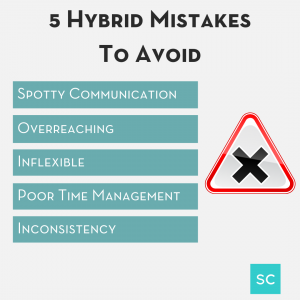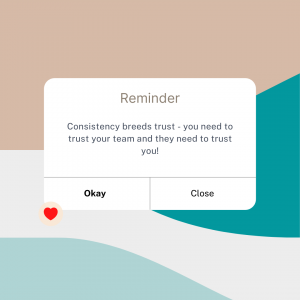5 HYBRID WORKING MISTAKES YOU WANT TO AVOID
 As more companies incorporate hybrid working models, there are bound to be mistakes made. In fact, Flex Jobs details how hybrid workplaces can become toxic fast. That’s concerning because toxic work environments can lead to unhappy employees and a higher turnover rate.
As more companies incorporate hybrid working models, there are bound to be mistakes made. In fact, Flex Jobs details how hybrid workplaces can become toxic fast. That’s concerning because toxic work environments can lead to unhappy employees and a higher turnover rate.
In order to succeed in this hybrid workplace, there are a few mistakes that you will want to avoid.
1. Spotty Communication
A huge mistake to avoid is being spotty with your communication. In the past, you may have been able to see your team in-person on a daily basis. You may have even had the opportunity to invite team members into your office as they passed by. But that isn’t the case anymore. Assuming that everyone knows what you want and what you need from them will get you nowhere fast. Set up your communications strategy right away!
Don’t assume anything in a hybrid working world!
In order to avoid spotty communication, consider the following:
How will I communicate? – Whether you prefer email or zoom calls, decide which channel you plan to communicate through, including when you’re actually in an office or at home.
Who do I need to stay in close contact with? – If you are in charge of leading one person or an entire team, always ensure you have a good temperature check of who you need to hear from. This is how you keep things flowing and productive? Do you need to hear from team leaders in marketing, development, or HR? If so, be sure to communicate with them frequently as well so you stay top of mind. The last thing you want is to miss an important message because they forgot to mention something or they couldn’t figure out a way to reach you.
Be Proactive. – Communicate and then communicate again. No one likes surprises because it makes them seem ill informed. Be sure to clue everyone into updates, announcements and progress reports.
Don’t make the mistake of spotty communication. Make communication your top priority moving forward.
2. Overreaching & Micromanaging
Overreaching and doing the work for someone else can lead to resentment and is a huge hybrid working mistake you will want to avoid. So what does overreaching look like?
- Taking over before your team has a chance to finish
- Not trusting that the work will get done
- Lack of information sharing
- Persistent messages/calls
As a team leader, your job is not to do the job of others. It’s to make sure projects and initiatives are aligned and that everyone knows what they need to do. In a hybrid world where we don’t often know what people are doing, it can cause folks to overreach and micromanage. But trusting your team and communicating with them frequently is key.
Give Your Team Time – Just because you can’t physically see your team doesn’t mean they aren’t working. Be sure that you are giving everyone ample time to get the job done. One of the huge perks of hybrid work is the ability to do work on a more flexible schedule. That means that while you may be working 9-5, other members of your team may be working earlier or later depending on what their schedule is like.
Set Expectations – Do you need to see a rough draft by a certain date? Make sure you set these expectations up right away. This will allow your team to have more autonomy as well as keep you from stepping in and finishing the job on your own.
Keep to the communication channel – Persistent messages, e-mails, and calls will only stress your team out. Avoid sounding the alarm unless it is truly necessary. If you’ve set up your remote visibility strategy and have your communications channels clearly defined, keep to it. Your team will feel more confident as they do their work.
3. Refusing To Be Flexible
Refusing to be flexible is a hybrid working mistake that you will want to avoid. There are several areas of flexibility that you will want to consider.
Communication Flexibility – Even if you have your communication channels planned, there will be times that you need to adapt. Perhaps Zoom is giving you issues, or maybe your company’s email accounts are down. Whatever the case may be, being flexible with your communication will help you and your team stay informed.
- Do you have a team member that has unreliable internet? Consider getting the company to get them a hot spot.
- Do you have a team member who is unable to make that Monday morning meeting? Consider ways to get them the information they need.
Remember, as a team leader, your job is to make sure everyone on your team can do their jobs. So, if you need to adapt your communication to enhance their work, do it!
Time Flexibility – Depending on which hybrid working model your company is using, your team may be working at all different times zones. This means your normal Monday morning meeting may not work for some team members. You will have to be flexible. Consider ways to include everyone.
- Make your presentations prerecorded so team members can watch them at any time
- Send a recap note
- If live participation is required consider everyone’s schedule before setting the meeting.
- Give ways for feedback that don’t necessarily have to be in real-time.
- Address concerns or issues when your team members are on the clock.
Technology Flexibility – The way you used to do things may not be the way you CAN do things anymore. If you come from a paper-heavy office, you may want to embrace an online cloud portal to keep all of your documents. Remember that some team members may not have the ability to print at home. So keep that in mind when delegating tasks.
Being flexible is part of the new hybrid working model. Creating a work environment that everyone can benefit from will grow your team and their success.
4. Poor Time Management
Time management is key to ensure productivity and it is even more important as you step into a hybrid working model. It can be easy to get distracted in your remote work environment. Depending on where you are, your home, a co-working space, or even a coffee shop – distractions are going to be all around you. And if you are not allowing yourself enough time to get your work done, you will be creating issues with your team and other people within your organization.
There are a few ways to foster good time management for yourself and your team.
- Set Clear Work Hours – Do you have clear working hours that your team knows about? Do you know their hours? It is so important that you communicate with your team about when everyone will be working. Remember, it may be different for each person.
- Too many meetings – Haven’t we all heard, well that could have just been an email? It’s true. Most of us have come to realize that many of the meetings we were required to attend could have easily been written in an email. So if you find that your work time is being taken up with too many meetings, your team is probably feeling the same way. Determine what is the most important go down the list of what is an absolute must meeting and what could simply be an email.
- Avoid Distractions – If you know that you can’t work in the same room as your spouse – find a better space for yourself. Create an environment that is free from distractions so that you can focus on the task at hand.
When you implement good time management for yourself, your team will follow your example. It is important for your team to see you adjusting when necessary so that everyone can be on the same page.
5. Inconsistency
 Entering into a hybrid work model can feel overwhelming. Everyone is trying to figure out how to communicate, how to get their work done, and what the new expectations are. A key to success is consistency. If you are inconsistent with communication – things are going to unravel. It is so important that you are consistent so that everyone on your team feels connected, heard, and in the loop.
Entering into a hybrid work model can feel overwhelming. Everyone is trying to figure out how to communicate, how to get their work done, and what the new expectations are. A key to success is consistency. If you are inconsistent with communication – things are going to unravel. It is so important that you are consistent so that everyone on your team feels connected, heard, and in the loop.
According to Workplace, consistency breeds trust. You need to trust your team and they need to trust you.
Keys for consistency
- Make time – If you plan to have a Monday morning meeting every week – make time for it and don’t miss it. If your schedule starts to fill up and you begin to postpone and reschedule on a regular basis, your team may not be able to see or hear vital information. On top of that, the meeting may seem unnecessary and team members may not make it their priority.
- Set Clear Expectations – One week you decide that this deadline is important and the next week you decide it isn’t. Because you aren’t able to go to a team member’s desk and hash out a change, randomly changing expectations is a huge mistake you will want to avoid. You can change your mind, things will come up, changes have to be made – but communicating those expectations has to be done in a consistent way!
- Focus – It can be hard to focus on all of the things – instead focus on one thing at a time. For example, the Monday morning meeting, make sure that is a non-negotiable focus. After you have been consistent with that, focus on the next goal. Over time you will fall into a pattern and rhythm with your team that is clear and consistent.
Hybrid work is exciting for many people, but it can also be daunting for leaders. The key to hybrid work is communication. Set up your communication channels. Focus on consistent communication. Be visible to your team. All of these will lead to hybrid working success.
__
Whenever you’re ready, there are 3 ways we can help you:
- Discover your communications style so you know where to start. Over 4,000 people have found theirs here.
- Attend our monthly communication workshop to build communications confidence (new topics: public speaking, advocating for yourself, building credibility, etc) here.
- Get your brand in front of 43k+ people by sponsoring our newsletter or Soulcast Media | LIVE LinkedIn events [contact: hello@soulcastmedia.com]











